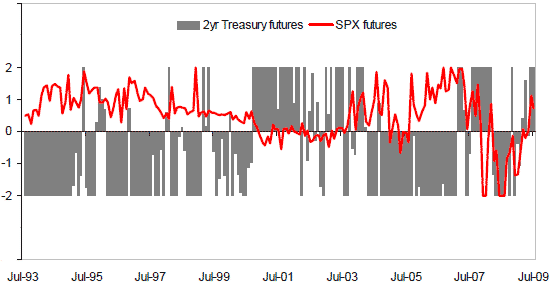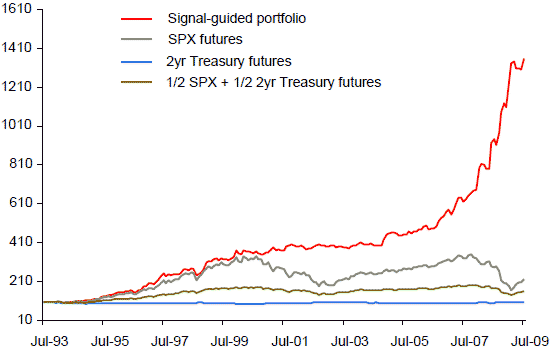Can the right macroeconomic indicators help investors beat the market? In their August 2009 paper entitled “Predictive Signals and Asset Allocation”, Hui Ou-Yang, Zhen Wei and Haochuan Zhang identify three predictive indicators for returns on the S&P 500 Index (SPX) and 2-year U.S. Treasury notes (T-note) and derive signals from these indicators to specify an outperforming dynamic allocation to SPX futures and T-note futures. The three indicators are: (1) the credit standard from the quarterly Senior Loan Officer Opinion Survey on Bank Lending Practices; (2) the percentage change in the daily Baltic Dry Index (BDI); and, (3) the change in the 2-year constant maturity swap (CMS) rate. They generate weights for the two futures (up to 200% each) at the end of each month from rolling 36-month regressions of indicators and past monthly asset returns. Using data for July 1990 through June 1993 to determine initial weights and data for July 1993 through June 2009 for testing (a total of 228 months), they conclude that:
- For July 1993 through June 2009, the average annualized excess return and return volatility for the modeled portfolio are 17.2% and 12.8%, for a Sharpe ratio of 1.34. Controlling for six equity and bond risk factors, the portfolio generate an annualized alpha of 14.8%.
- In the last five years and three years, the portfolios generate alphas (Sharpe ratios) of 23.8% and 31.1% (1.76 and 2.12), respectively.
- The maximum drawdown for the portfolio during the highly volatile subperiod of July 2006 through June 2009 is -3.3%.
- Results are robust to variation of the rolling regression interval.
- The average monthly turnovers for the SPX and T-note futures positions are 41% and 87%, respectively. Hence, an average bid-ask spread of 0.02% indicates an average annual trading friction around 0.31%, which is small compared to the annualized excess return of 17.2%.
The following chart, taken from the paper, tracks the weights for for the two assets in the modeled portfolio (up to 200% for each) over the sample period. The weights successfully anticipate both the stock market drop in 2008 and the recovery in early 2009.

The next chart, also from the paper, presents the cumulative excess returns for initial investments of $100 at the beginning of July 1993 in the modeled portfolio and in several simple alternatives. The modeled portfolio outperforms, with much of the outperformance coming the last two years of the sample period.

In summary, allocating funds to stocks and Treasuries according to the relationships between their past returns and these three off-the-beaten-path macroeconomic indicators may produce market-beating results.